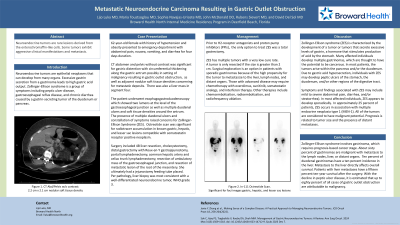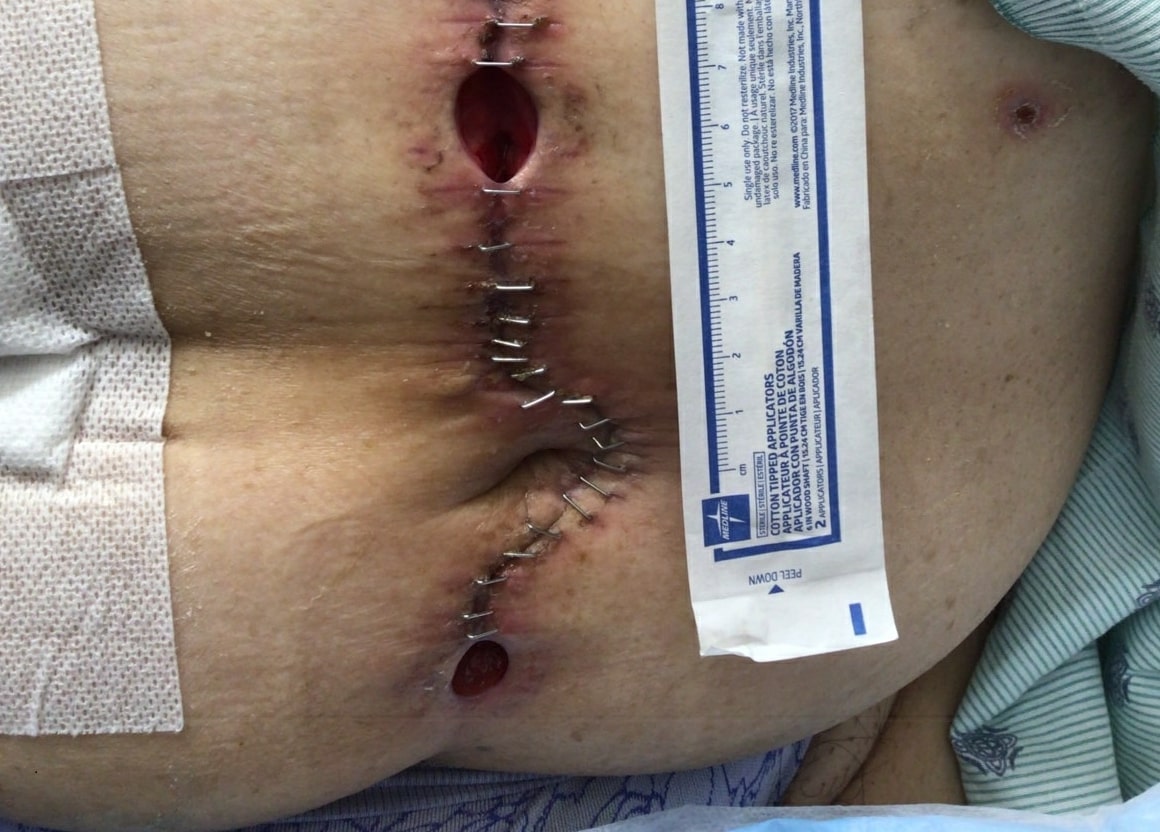Sunday Poster Session
Category: Stomach
P1679 - Metastatic Neuroendocrine Carcinoma Resulting in Gastric Outlet Obstruction
Sunday, October 27, 2024
3:30 PM - 7:00 PM ET
Location: Exhibit Hall E

Has Audio

Lijo Luka, MD
Broward Health North
Pompano Beach, FL
Presenting Author(s)
Lijo Luka, MD, Maria Toustsoglou, MD, Sophia Navajas-Urioste, MD, David Del Sol, MD
Broward Health North, Pompano Beach, FL
Introduction: Neuroendocrine tumors are epithelial neoplasms that can develop from many organs. Excessive gastrin secretion from a gastrinoma leads to high gastric acid output. Zollinger-Ellison syndrome is a group of symptoms including peptic ulcer disease, gastroesophageal reflux disease, and chronic diarrhea caused by a gastrin-secreting tumor of the duodenum or pancreas.
Case Description/Methods: 62-year-old female with history of hypertension and obesity presented to emergency department with abdominal pain, nausea, vomiting, and diarrhea for four days duration.
CT abdomen and pelvis without contrast was significant for gastric distention with circumferential thickening along the gastric antrum possibly in setting of malignancy resulting in gastric outlet obstruction as well as adjacent nodular soft tissue densities concerning for metastatic deposits. There was also a liver mass in segment four, highly concerning for liver metastasis.
She underwent esophagogastroduodenoscopy which showed two lumens at the level of the gastroesophageal junction as well as multiple duodenal ulcers and soft tissue densities around the antrum suspicious for metastatic disease. The presence of multiple duodenal ulcers and constellation of symptoms raised concerns for Zollinger-Ellison syndrome.
Octreotide scan was significant for radiotracer accumulation in known gastric, hepatic, and lesser sac lesions compatible with somatostatin receptor positive neoplasm.
The patient underwent 4B liver resection, cholecystectomy, distal gastrectomy with Roux-en-Y gastrojejunostomy, portal lymphadenectomy, common hepatic artery and celiac trunk lymphadenectomy, resection of ambulatory mass of the gastroesophageal junction, and resection of metastatic lesion of the root of the mesentery. She ultimately had a jejunostomy feeding tube placed.
Per pathology, liver biopsy was most consistent with a well-differentiated neuroendocrine tumor, WHO grade 3.
Discussion: Zollinger-Ellison syndrome involves gastrinoma, which requires prognosis-based cancer stage. About sixty percent of gastrinomas are malignant with metastasis to the lymph nodes, liver, or distant organs. Ten percent of duodenal gastrinomas have a ten percent incidence in the liver. Metastasis to the liver directly affects overall survival. Patients with liver metastases have a fifteen percent ten-year survival after the surgery. With the decline in peptic ulcer disease, it is estimated that up to eighty percent of all cases of gastric outlet obstruction are attributable to malignancy.

Disclosures:
Lijo Luka, MD, Maria Toustsoglou, MD, Sophia Navajas-Urioste, MD, David Del Sol, MD. P1679 - Metastatic Neuroendocrine Carcinoma Resulting in Gastric Outlet Obstruction, ACG 2024 Annual Scientific Meeting Abstracts. Philadelphia, PA: American College of Gastroenterology.
Broward Health North, Pompano Beach, FL
Introduction: Neuroendocrine tumors are epithelial neoplasms that can develop from many organs. Excessive gastrin secretion from a gastrinoma leads to high gastric acid output. Zollinger-Ellison syndrome is a group of symptoms including peptic ulcer disease, gastroesophageal reflux disease, and chronic diarrhea caused by a gastrin-secreting tumor of the duodenum or pancreas.
Case Description/Methods: 62-year-old female with history of hypertension and obesity presented to emergency department with abdominal pain, nausea, vomiting, and diarrhea for four days duration.
CT abdomen and pelvis without contrast was significant for gastric distention with circumferential thickening along the gastric antrum possibly in setting of malignancy resulting in gastric outlet obstruction as well as adjacent nodular soft tissue densities concerning for metastatic deposits. There was also a liver mass in segment four, highly concerning for liver metastasis.
She underwent esophagogastroduodenoscopy which showed two lumens at the level of the gastroesophageal junction as well as multiple duodenal ulcers and soft tissue densities around the antrum suspicious for metastatic disease. The presence of multiple duodenal ulcers and constellation of symptoms raised concerns for Zollinger-Ellison syndrome.
Octreotide scan was significant for radiotracer accumulation in known gastric, hepatic, and lesser sac lesions compatible with somatostatin receptor positive neoplasm.
The patient underwent 4B liver resection, cholecystectomy, distal gastrectomy with Roux-en-Y gastrojejunostomy, portal lymphadenectomy, common hepatic artery and celiac trunk lymphadenectomy, resection of ambulatory mass of the gastroesophageal junction, and resection of metastatic lesion of the root of the mesentery. She ultimately had a jejunostomy feeding tube placed.
Per pathology, liver biopsy was most consistent with a well-differentiated neuroendocrine tumor, WHO grade 3.
Discussion: Zollinger-Ellison syndrome involves gastrinoma, which requires prognosis-based cancer stage. About sixty percent of gastrinomas are malignant with metastasis to the lymph nodes, liver, or distant organs. Ten percent of duodenal gastrinomas have a ten percent incidence in the liver. Metastasis to the liver directly affects overall survival. Patients with liver metastases have a fifteen percent ten-year survival after the surgery. With the decline in peptic ulcer disease, it is estimated that up to eighty percent of all cases of gastric outlet obstruction are attributable to malignancy.

Figure: Patient underwent 4B liver resection, cholecystectomy, distal gastrectomy with Roux-en-Y gastrojejunostomy, portal lymphadenectomy, common hepatic artery and celiac trunk lymphadenectomy, resection of ambulatory mass of the gastroesophageal junction, and resection of metastatic lesion of the root of the mesentery,
Disclosures:
Lijo Luka indicated no relevant financial relationships.
Maria Toustsoglou indicated no relevant financial relationships.
Sophia Navajas-Urioste indicated no relevant financial relationships.
David Del Sol indicated no relevant financial relationships.
Lijo Luka, MD, Maria Toustsoglou, MD, Sophia Navajas-Urioste, MD, David Del Sol, MD. P1679 - Metastatic Neuroendocrine Carcinoma Resulting in Gastric Outlet Obstruction, ACG 2024 Annual Scientific Meeting Abstracts. Philadelphia, PA: American College of Gastroenterology.
